Abstract
Quantitative structure–activity relationship (QSAR) study has been conducted on 36 terpene derivatives with anticonvulsant activity in timed pentylenetetrazole (PTZ) infusion test. QSAR models for anticonvulsant activity prediction of hydrazones and esters of some monocyclic/bicyclic terpenoids were developed using simplex representation of molecular structure (SiRMS; informational field [IF]) approach based on the SiRMS and the IF of molecule. Four 2D partial least squares QSAR consensus models were developed with the coefficient of determination for test sets
1 Introduction
The field of drug investigation aimed at seizure prevention during epilepsy has become a cornerstone in medicinal chemistry due to the limitations of existing antiepileptic medications such as ineffectiveness or various side effects: diplopia, dizziness, ataxia, sedation, and so on [1]. In this context, particular attention is paid on natural biologically active substances including glycosides, coumarins, flavonoids, alkaloids, and terpenoids that have limited or no toxic side effects [2]. The latter compounds were found to positively modulate human recombinant γ-aminobutyric acid type A receptors (GABAA) receptors or activate glutamic acid decarboxylase enzyme (a key enzyme in the biosynthesis of GABA) confirming terpenoids' potential for the treatment of epilepsy and seizures [3]. To enhance anticonvulsant properties, terpenes/terpenoids were synthetically converted to miscellaneous derivatives comprising hydrazones [4,5,6], epoxides [7], and esters [8,9]. The main concept of modification consists in pharmacophore fragments introduction into the molecule leading to increased bonding to receptors. In contrast, the labile bonds of the aforementioned compounds undergo hydrolytic cleavage both in vitro and in vivo followed by the release of active ingredients [10].
To date, the creation of a new medicine costs more than 1 billion dollars and the costs of this process are growing up steadily [11]. Therefore, different theoretical approaches are used for a facilitation and acceleration of a new drugs development process that is very expensive, multistep, and prolonged [12]. To this end, quantitative structure–activity relationship (QSAR) analysis is widely applied for virtual screening of potential bioactive compounds followed by their structure optimization. QSAR methods allow discovering correlation between numerical physicochemical property or molecular feature of compounds and their biological or pharmacological activity [13]. The present study is a logical continuation of our current research devoted to the QSAR analysis for a number of terpene derivatives [14]. The goal of our study is to develop predictive QSAR models for anticonvulsant activity assessment of terpenoids and their derivatives.
2 Materials and methods
The data set consisting of 36 terpene derivatives was used in the current study: hydrazones of menthone, carvone, and verbenone and esters of menthol, thymol, carvacrol, borneol, eugenol, and guaiacol. Minimum effective doses (MEDs) of convulsant pentylenetetrazole (PTZ) that induce clonic–tonic convulsions (DCTC) and tonic extension (dose inducing tonic extension [DTE]) in experimental animals have been registered and used as properties. Anticonvulsant activity of terpene derivatives was estimated at different time points – 3 and 24 h after oral administration according to the described procedure [15]. Thus, four data sets were formed: two of which contain information on PTZ MED causing clonic–tonic seizures determined after 3 and 24 h, DCTC (3 h) and DCTC (24 h), and the other two with data on PTZ MED causing tonic extension, DTE (3 h) and DTE (24 h), respectively.
For all the investigated compounds, the structural descriptors were calculated using the simplex representation of molecular structure (SiRMS; informational field [IF]) approach [16]. QSAR methods on the basis of SiRMS [17,18] along with the IF of molecule [19] already demonstrated their efficiency when dealing with variety of QSAR tasks. Two different methods are united in the system of structural parameters resulting in system (SiRMS (IF)) that exhibits versatility of simplex approach along with sensitivity to the structural features within the scope of IF. Through the use of SiRMS (IF) approach, simplex vertexes might be better differentiated since informational potential (IP) vary according to the impact of near and far surroundings. In SiRMS (IF), the IF characteristics are applied for atom’s differentiation in simplexes. Notably, the potentials of the aforementioned IFs weighed by different atomic properties (charge, lipophilicity, electronic polarizability, etc.) might be exploited.
In this study, SiRMS (IF) approach has been applied for the representation of molecular structure at 2D level. According to this model, each molecule can be represented in the form of molecular graph. The vertices of such a graph provide a whole range of information which spreads only on the graph edges. Noteworthy, all potential bindings between every atom pair are recognized:
The topological IP of ith atom can be described as [16]
where m is the number of all possible paths between every atom pair, n is the number of atoms in the given molecule, R
ij
is the number of bonds between the ith and jth atoms (path length), w
i
is the weighed parameters describing any property (p) of the atoms (w
i
= 1 in the case of unweighted IP), and r is the tuning parameter of the model,
The example of simplex differentiation on the basis of atomic topologic IP for alanine at 2D level is shown in Figure 1.
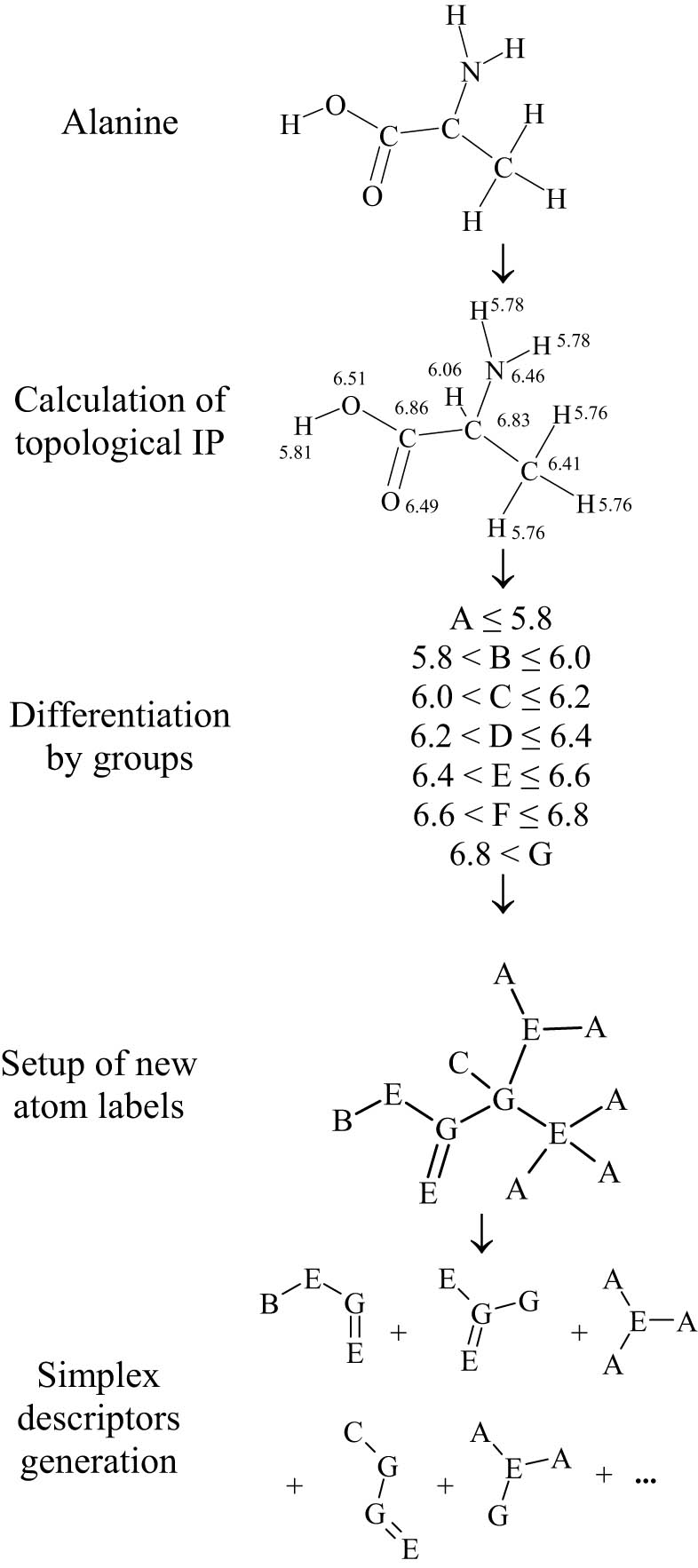
Example of simplex descriptor generation using atomic topological IPs for alanine at 2D level.
For the weighed molecular topological IPs in the preliminary stage, the range of all possible values is divided into a certain number of discrete groups. The number of groups is a tuning parameter. The label of an atom is determined from the point of view of its belonging to a particular group. The following schemes were used in the calculation of simplex-informational descriptors:
Unweighted topological IP: A < 3.45 ≤ B < 3.84 ≤ C < 4.22 ≤ D < 4.60 ≤ E < 4.99 ≤ F < 5.37 ≤ G.
Topological IP weighed by electronegativity: A < 3.51 ≤ B < 3.89 ≤ C < 4.27 ≤ D < 4.65 ≤ E < 5.03 ≤ F < 5.41 ≤ G.
Topological IP weighed by refraction: A < 3.65 ≤ B < 4.02 ≤ C < 4.38 ≤ D < 4.75 ≤ E < 5.12 ≤ F < 5.49 ≤ G.
Topological IP weighed by atomic charge: A < −0.51 ≤ B < −0.38 ≤ C < −0.26 ≤ D < −0.13 ≤ E < 0 ≤ F < 0.12 ≤ G.
Topological IP weighed by van der Waals radius: A < 3.75 ≤ B < 4.11 ≤ C < 4.47 ≤ D < 4.83 ≤ E < 5.2 ≤ F < 5.56 ≤ G.
Topological IP weighed by lipophilicity: A < 0.58 ≤ B < 1.32 ≤ C < 2.06 ≤ D < 2.81 ≤ E < 3.55 ≤ F < 4.29 ≤ G.
A total of 2,374 simplex-informational descriptors were calculated for the investigated molecules. log P (I.log P), molecular refraction (I.RF), equalized electronegativity (I.EN), and molecular mass (I.AW) were used as trivial integral parameters of the molecules [17,18]. The relationships between calculated descriptors and investigated properties were established with common method of partial least squares (PLS) [20]. The removal of highly correlated and constant descriptors, the trend vector method [21], genetic algorithm [22], and the automatic variable selection strategy [18] have all been used to select the descriptors in PLS. Structures of monocyclic/bicyclic terpenoids and their derivatives used in this study and corresponding values of their anticonvulsant activity are collected in Table 1.
Structures and anticonvulsant activities of terpenes and their derivatives
| Structure | Core | R i | 3 h | 24 h | ||
|---|---|---|---|---|---|---|
| DCTC (%) | DTE (%) | DCTC (%) | DTE (%) | |||
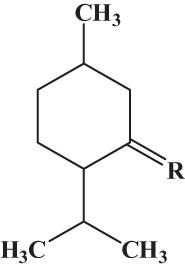 |
A | R1 | 157 | 197 | 166 | 176 |
| R2 | 171 | 182 | 191 | 205 | ||
| R3 | 223 | 261 | 200 | 224 | ||
| R4 | 177 | 203 | 177 | 189 | ||
| R5 | 189 | 232 | 166 | 182 | ||
| R6 | 174 | 179 | 169 | 182 | ||
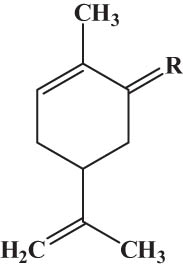 |
B | R1 | 196 | 200 | 130 | 138 |
| R2 | 193 | 204 | 240 | 220 | ||
| R3 | 267 | 269 | 204 | 204 | ||
| R4 | 227 | 246 | 204 | 208 | ||
| R5 | 221 | 233 | 209 | 227 | ||
| R6 | 196 | 204 | 204 | 212 | ||
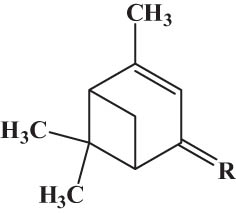 |
C | R1 | 179 | 180 | 130 | 138 |
| R2 | 218 | 212 | 240 | 220 | ||
| R3 | 278 | 303 | 204 | 204 | ||
| R4 | 207 | 235 | 204 | 208 | ||
| R5 | 216 | 230 | 209 | 227 | ||
| R6 | 160 | 162 | 204 | 212 | ||
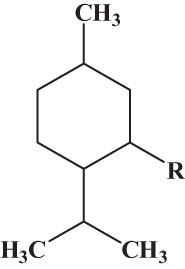 |
D | R7 | 167 | 186 | 167 | 189 |
| R8 | 162 | 192 | 162 | 194 | ||
| R9 | 152 | 186 | 167 | 189 | ||
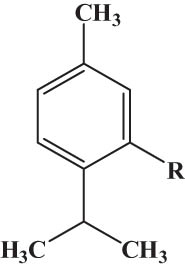 |
E | R7 | 213 | 181 | 214 | 183 |
| R8 | 207 | 190 | 208 | 189 | ||
| R9 | 198 | 144 | 198 | 132 | ||
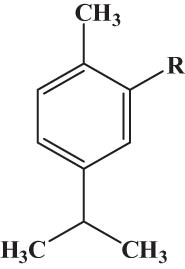 |
F | R7 | 197 | 142 | 197 | 127 |
| R8 | 235 | 155 | 226 | 152 | ||
| R9 | 154 | 136 | 144 | 133 | ||
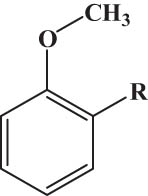 |
G | R7 | 186 | 157 | 179 | 147 |
| R8 | 214 | 207 | 203 | 203 | ||
| R9 | 183 | 114 | 186 | 108 | ||
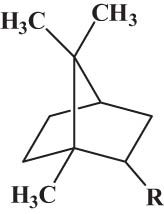 |
H | R7 | 190 | 207 | 183 | 208 |
| R8 | 242 | 161 | 267 | 171 | ||
| R9 | 217 | 165 | 217 | 158 | ||
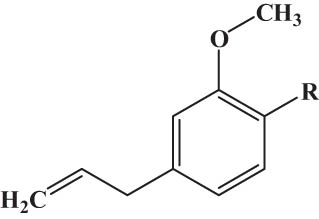 |
I | R7 | 240 | 156 | 241 | 155 |
| R8 | 210 | 156 | 212 | 159 | ||
| R9 | 168 | 168 | 159 | 176 | ||
Note: R1: O; R2–R6: 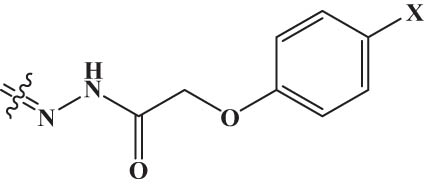 X = H (R2); Br (R3); Cl (R4); C(CH3)3 (R5); O–Ph (R6); R7: –OOC–(CH2)3–NH2; R8: –OOC–CH2–NH2; R9: –OH.
X = H (R2); Br (R3); Cl (R4); C(CH3)3 (R5); O–Ph (R6); R7: –OOC–(CH2)3–NH2; R8: –OOC–CH2–NH2; R9: –OH.
DCTC, dose inducing clonic–tonic convulsions; DTE, dose inducing tonic extension.
QSAR investigations must be used to make predictions for compounds with unknown activity. Five-fold cross-validation was performed for each property to assess the prediction ability. The molecules within each data set are ordered according to the values of their anticonvulsant activity and then every fifth molecule in this row is selected into the test set. Significantly, among the five data sets obtained, each molecule enters in the test set only once. The test set (20% of the total number of molecules) is excluded from the model building process. Based on the training set data, a model used to predict the properties of test set compounds is built. Thus, for each of the four data sets (DCTC [3 h], DCTC [24 h], DTE [3 h], DTE [24 h]), five data sets are formed, each containing training and test sets.
According to the OECD principles of QSAR model validation, in this task, the following domain applicability (DA) procedures were used:
This method is based on the estimation of leverage value h i . It has been visualized as the Williams plot [23]. The new molecule is situated outside of the DA if h i > h cr = 3(A + 1)/N, where N is the number of molecules in a work set.
DA ellipsoid that developed [17], where the distribution of a training set of molecules in a space of latent variables (A) T 1–T A (axes of coordinates), can be obtained from the PLS. DA represents an ellipsoid that is built from the molecules at the center of the training set (T 1 = 0; T 2 = 0) with the semiaxes length 3ST1 and 3ST2, respectively (where ST1 and ST2 are the root mean square deviations). The prognoses for molecules approximated to the center of the DA are the most reliable.
The “randomization” procedure (Y-scrambling) [18] was used to confirm the “nonrandomness” of the developed QSAR models. Y-scrambling procedure is the creation of the models using the method of random selection of coefficients. The essence of this method is that after developing the model on a work set, random mixing of the values of the property is carried out. If the model is retrained, then a fairly good model will be obtained on the Y-randomized set. If the model parameters do not lead to retraining, then after Y-randomization, there will be a significant deterioration in the descriptive ability of the model.
The following formulas were used for calculating of statistical characteristics:
where
To calculate simplex-informational descriptors and integral parameters of the molecules and also to develop QSAR models, software HiTQSAR developed in the Department of Molecular Structures and Chemoinformatics (A.V. Bogatsky Physical-Chemical Institute NAS of Ukraine) was used.
3 Results and discussion
At the first stage, in the construction of PLS ratios, all molecules were included in the study (a training set of 36 terpene derivatives). For DCTC (3 h), DCTC (24 h), DTE (3 h), and DTE (24 h) data sets 2D PLS QSAR models M1–M4 were developed. Models M1–M4 had the number of latent variables A = 2 and adequate statistical characteristics (Table 2).
The statistical characteristics of 2D QSAR models
| Model | Anticonvulsant activity | Work set | Leave-one-out | Y-Scrambling | |||||
|---|---|---|---|---|---|---|---|---|---|
| R 2 | RMSE | MAE | Q 2 | RMSE | MAE | R 2 | Q 2 | ||
| M1 | DCTC (3 h) | 0.88 | 10.6 | 7.9 | 0.81 | 13.5 | 10.1 | 0.26 ± 0.03 | 0.11 ± 0.03 |
| M2 | DCTC (24 h) | 0.91 | 9.2 | 7.4 | 0.81 | 13.5 | 10.6 | 0.17 ± 0.02 | 0.08 ± 0.02 |
| M3 | DTE (3 h) | 0.80 | 15.6 | 12.1 | 0.75 | 18.0 | 14.1 | 0.14 ± 0.02 | 0.04 ± 0.03 |
| M4 | DTE (24 h) | 0.90 | 9.9 | 8.0 | 0.86 | 12.4 | 9.8 | 0.19 ± 0.03 | 0.11 ± 0.03 |
Note: R 2 – coefficient of determination; Q 2 – coefficient of determination for cross validation (leave-one-out); RMSE – root mean square error; MAE – mean absolute error.
The models obtained using the Y-scrambling procedure had low values of
Five-fold cross-validation was performed for each property to assess the prediction ability. Adequate 2D QSAR models were obtained and used further as basis for the consensus models. For consensus models, the coefficient of determination for test sets was found to be
The statistical characteristics of consensus models (test set)
| Anticonvulsant activity | R 2 | RMSE | MAE |
|---|---|---|---|
| DCTC (3 h) | 0.62 | 18.8 | 15.3 |
| DCTC (24 h) | 0.79 | 13.9 | 11.6 |
| DTE (3 h) | 0.75 | 17.6 | 14.3 |
| DTE (24 h) | 0.81 | 14.7 | 11.2 |
Noteworthy, the quality of the models for 24 h is better than those for 3 h that, obviously, may be due to the fact that some compounds fully manifest their activity after time. Relationship between observed and predicted values of anticonvulsant activities for the test set within the consensus models for four sets is presented in Figure 2a–d. As described, significant correlation between observed and predicted values of anticonvulsant activities in DCTC (3 h), DCTC (24 h), DTE (3 h), and DTE (24 h) sets was revealed for the majority of compounds.
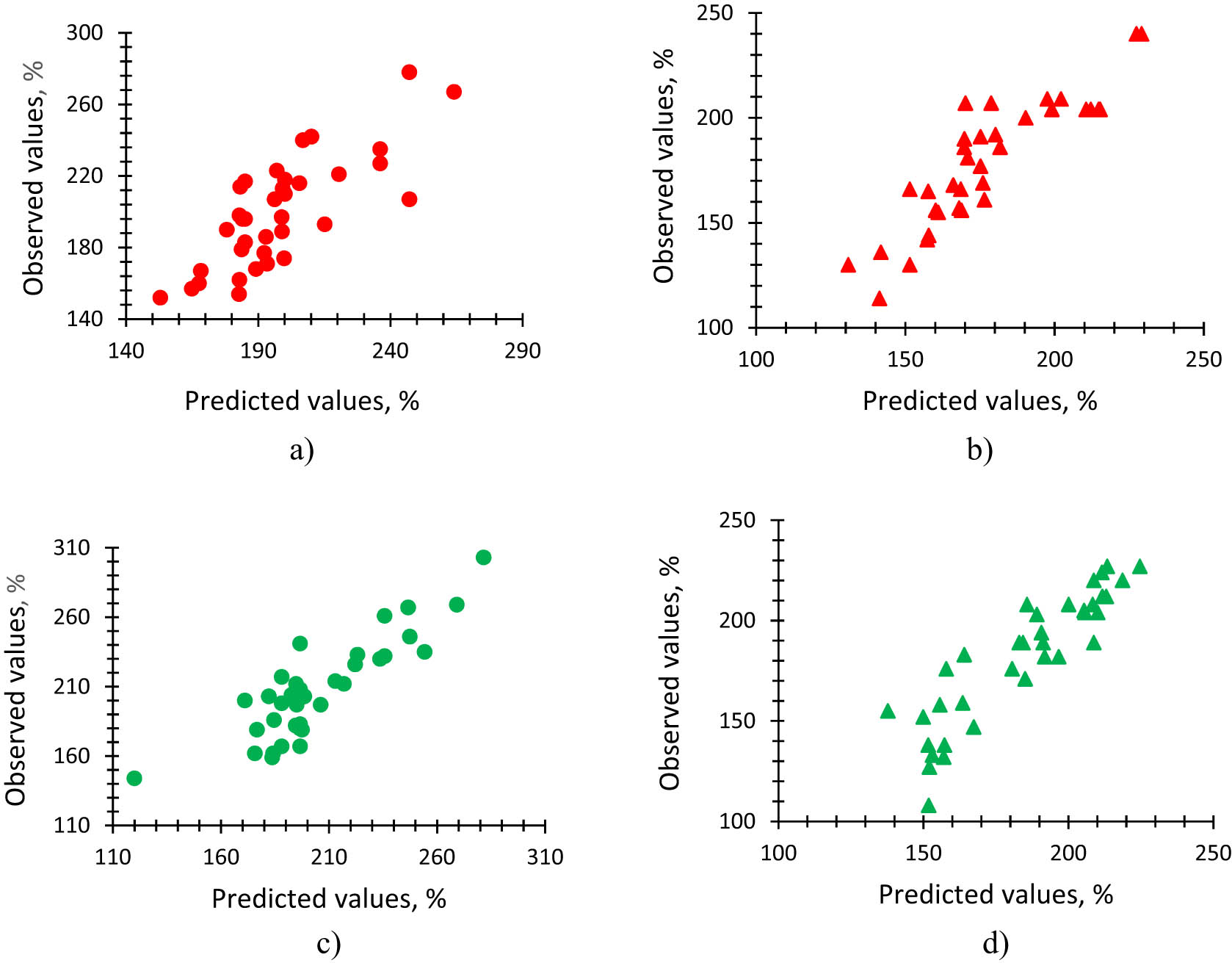
Observed versus predicted diagram for anticonvulsant activities of terpene derivatives: (a) DCTC (3 h); (b) DCTC (24 h); (c) DTE (3 h); and (d) DTE (24 h).
Physicochemical and structural interpretation of the models was carried out based on consensus 2D-QSAR models developed for the DCTC (3 h), DCTC (24 h), DTE (3 h), and DTE (24 h) samples. To define the relative influence of the different physical and chemical factors on the character of the molecules interaction with the biological target, it is necessary to sum and compare absolute values of PLS regression coefficients of simplexes for all used groups for atom differentiation. Figure 3 shows the relative influence of some physicochemical factors on the anticonvulsant activity of terpene derivatives at 3 and 24 h after oral administration. As seen, the analysis of the obtained 2D QSAR model using SiRMS (IF) approach confirms that in all cases the contribution of electrostatic factor is predominant (48–63%). Equally important factors are the steric factors that are determined, on the one hand, by values of the van der Waals radii (20–35%), and on the other hand, by topology which is associated with the molecular form (13–22%). Lipophilicity effect in all instances was minimal, less than 9% from the sum of all considered factors.
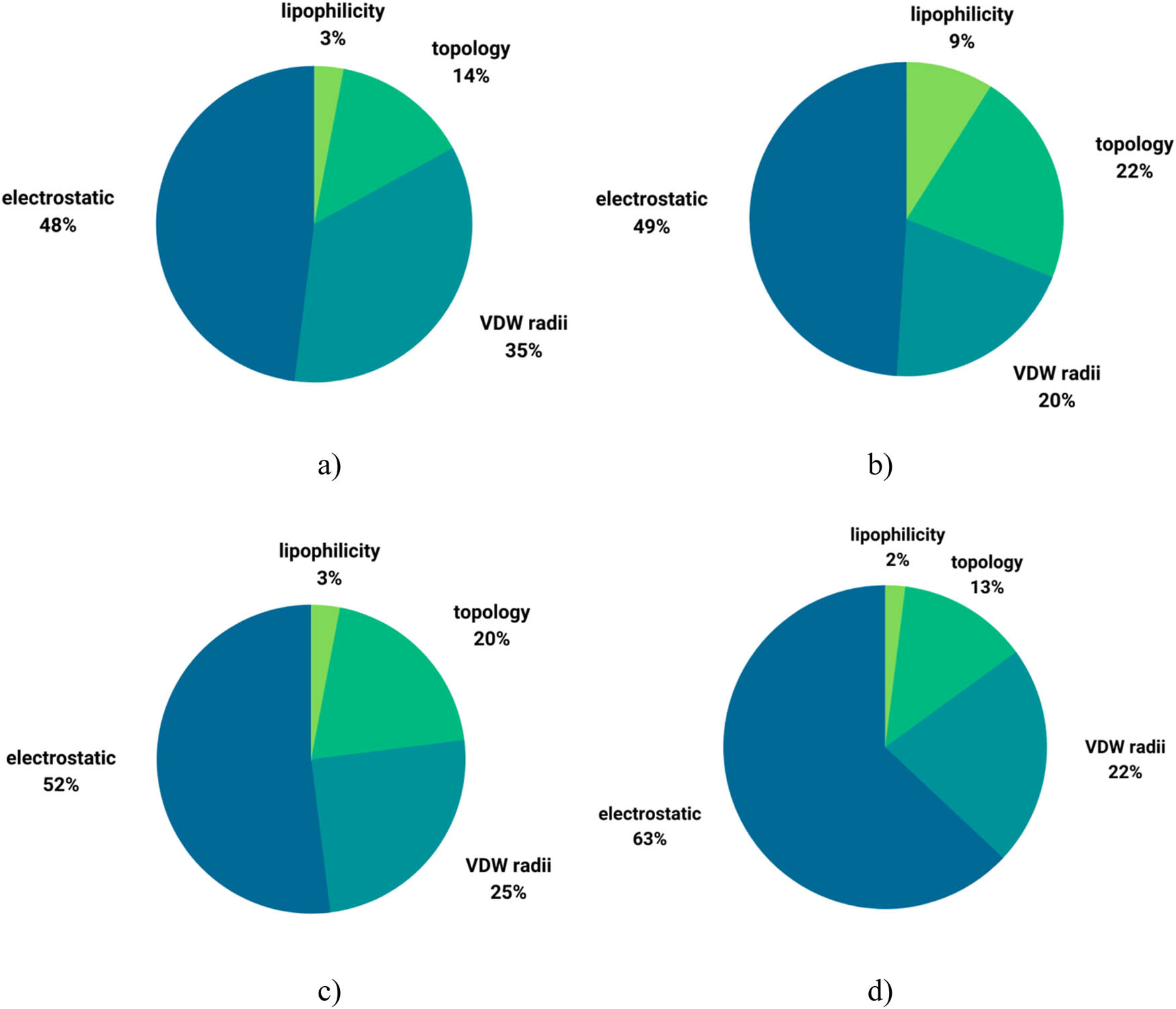
Relative influence of some structural factors on anticonvulsant activity of terpene derivatives estimated on the basis of consensus 2D-QSAR models: (a) DCTC (3 h); (b) DCTC (24 h); (c) DTE (3 h); and (d) DTE (24 h).
One of SiRMS approach advantages, also proper to the SiRMS (IF), is the possibility of appropriate structural interpretation. The influence of each atom (as a part of simplex) into investigated property can be calculated on the basis of the obtained QSAR models [17,18]. The contribution (C) of each j-atom in the molecule can be defined as the ratio of the sum of PLS regression coefficient (b
I
) of all simplexes this atom contains (M) to the number of atoms (n) in the simplex (or fragment):
The entire set consisting of 36 terpene derivatives was divided into nine subgroups in which the effect of R substituents was analyzed. The contribution of the structural cores A–I was also evaluated (Table 4).
Relative contribution of structural cores on anticonvulsant activity of terpenoids and their derivatives
| Cores | DCTC (3 h) | DCTC (24 h) | DTE (3 h) | DTE (24 h) |
|---|---|---|---|---|
| A | −1.3 | 4.8 | 8.5 | 7.5 |
| B | 17.7 | 18.7 | 18.8 | 9.6 |
| C | 14.8 | 13.1 | 19.8 | 5.9 |
| D | −18.4 | 1.2 | −12.8 | 23.8 |
| E | 6.6 | −2.9 | 4.8 | 1.2 |
| F | 8.6 | −15.4 | −0.1 | −16.8 |
| G | 1.2 | −12.9 | −0.6 | −9.5 |
| H | 5.5 | 0.5 | 17.9 | 8.7 |
| I | 15.3 | −4.9 | 11.1 | −5.0 |
The higher the value of the MEDs of seizure agent that induce DCTC and DTE, the greater the anticonvulsant effect of the compound. As demonstrated in Table 3, carvone (B) and verbenone (C) nuclei were discovered to facilitate the manifestation of anticonvulsant activity in the case of DCTC (3 h) and DCTC (24 h). The influence of eugenol nucleus (I) in its derivatives prevents the manifestation of anticonvulsant activity with increase in time after oral administration of compounds. The effects of menthol (D) and menthone (A) nuclei become positive during the transition from 3 to 24 h after the administration of their derivatives; consequently, the presence of the aforementioned nuclei in the molecule structure will contribute to the expression of antiseizure action. This phenomenon might be explained by higher lipophilicity of menthone (log P 2.63) core compared with verbenone (log P 1.97) and carvone (log P 2.26) leading to prolonged action of menthone derivatives and their more pronounced activity over a long time period (24 h).
In the case of DTE (3 h), the nuclei of verbenone (C), carvone (B), and borneol (H) derivatives were the most conducive to the manifestation of anticonvulsant activity. Similarly to DCTC, the presence of menthol nucleus (D) initially prevents the expression of effect; however, over time its effect becomes reversed leading to enhanced seizure protection due to gradual enzymatic hydrolysis of ester bond in menthol derivatives. Generally, the presence of carvone (B), verbenone (C), and borneol (H) nuclei in the structure of terpenoid derivatives at all time periods (3 and 24 h) promote the demonstration of anticonvulsant activity on the model of PTZ-induced seizures. Comparative analysis of substituent (R) contribution to anticonvulsant effect was also conducted and its results are summarized in Table 5.
Relative contribution of molecular fragments on anticonvulsant activity of terpenoids and their derivatives
| Structural cores | Fragments (R) | DCTC (3 h) | DCTC (24 h) | DTE (3 h) | DTE (24 h) |
|---|---|---|---|---|---|
| A | R1 | 0.1 | 0 | 0 | 0.4 |
| R2 | 3.1 | 14.1 | −2.9 | 33.8 | |
| R3 | 20.3 | 10.2 | 32.7 | 34.6 | |
| R4 | 7.2 | 8.8 | 4.9 | 33.7 | |
| R5 | 8.4 | 1.9 | 30.3 | 20.0 | |
| R6 | −6.3 | 4.3 | −10.2 | 10.2 | |
| B | R1 | 0.1 | 0 | 0 | 0.4 |
| R2 | 9.1 | 21.6 | 0.1 | 40.3 | |
| R3 | 24.6 | 14.9 | 30.0 | 35.7 | |
| R4 | 15.8 | 17.5 | 11.8 | 37.3 | |
| R5 | 25.1 | 15.5 | 38.9 | 48.0 | |
| R6 | 4.2 | 16.1 | −3.2 | 40.3 | |
| C | R1 | 0.1 | 0 | 0 | 0.4 |
| R2 | 12.9 | 24.9 | 3.4 | 39.8 | |
| R3 | 25.2 | 18.1 | 37.2 | 35.9 | |
| R4 | 15.8 | 19.6 | 27.8 | 36.0 | |
| R5 | 18.8 | 17.5 | 33.1 | 47.4 | |
| R6 | −8.3 | 14.5 | −7.2 | 38.8 | |
| D | R7 | −3.9 | 4.9 | −2.3 | 5.7 |
| R8 | −7.6 | 6.5 | −4.2 | 7.6 | |
| R9 | −5.1 | 1.3 | −0.5 | 1.3 | |
| E | R7 | 5.9 | 3.6 | 4.4 | 3.2 |
| R8 | 6.6 | 4.1 | 13.6 | 7.0 | |
| R9 | −0.3 | 0.2 | 0 | 0.5 | |
| F | R7 | 25.7 | −2.3 | 15.2 | 4.4 |
| R8 | 4.6 | −2.0 | 6.6 | 1.2 | |
| R9 | −4.6 | −0.02 | −0.1 | 0.5 | |
| G | R7 | 3.9 | 18.6 | 2.3 | 26.9 |
| R8 | 0.3 | 2.2 | 2.4 | 8.4 | |
| R9 | −0.6 | −0.2 | −0.8 | 0.5 | |
| H | R7 | 24.9 | −1.7 | 31.2 | 4.4 |
| R8 | 3.9 | 8.1 | −1.4 | 12.7 | |
| R9 | 2.0 | −0.3 | 3.7 | 0.5 | |
| I | R7 | 14.5 | 1.9 | 5.6 | 6.3 |
| R8 | 8.1 | 2.3 | 12 | 6.0 | |
| R9 | 0.1 | 0.9 | −1.5 | 2.2 |
DCTC, dose inducing clonic–tonic convulsions; DTE, dose inducing tonic extension.
When analyzing the influence of substituents (R1–R9) on the manifestation of anticonvulsant activity, it was found that the replacement of the carbonyl group linked to the cyclic terpene fragment with hydrazone substituents as well as replacement of the hydroxyl group with GABA or glycine residues resulted in strengthening of antiseizure action.
4 Conclusion
In the present study, QSAR models for anticonvulsant activity prediction of hydrazones and esters based on monocyclic/bicyclic terpenoids were developed using SiRMS (IF) approach, which captured the essence of simplex representation for molecular structure and its IF. Physicochemical and structural interpretation of the models was carried out. The contribution of electrostatic factor on the anticonvulsant activity of terpene derivatives at 3 and 24 h after oral administration is predominant (48–63%). Equally important factors are the steric factors: values of the van der Waals radii (20–35%) and topology (13–22%). Molecular fragments responsible for the manifestation of anticonvulsant action defined on the basis of the developed models. In particular, we found that carvone, verbenone cores possess the most significant contribution to antiseizure action examined on the model of PTZ-induced convulsions at 3 and 24 h after oral administration of terpene derivatives. Moreover, carbonyl and hydroxy group substitution in terpenoid molecules followed by hydrazones and esters formation leads to enhancement and prolongation of antiseizure action due to the contribution of additional molecular fragments. The presented QSAR models contribute significantly to design of novel terpene derivatives for oral administration against onset seizures.
Abbreviations
- DA
-
domain applicability
- DCTC
-
dose inducing clonic–tonic convulsions
- DTE
-
dose inducing tonic extension
- MAE
-
mean absolute error
- MED
-
minimum effective dose
- PTZ
-
pentylenetetrazole
- QSAR
-
quantitative structure–activity relationship
- RMSE
-
root mean square error
- SiRMS
-
simplex representation of molecular structure
- IF
-
informational field
- IP
-
informational potential
- PLS
-
partial least squares
-
Funding information: No funding to declare.
-
Author contributions: All authors contributed to the study conception and design. M.N., L.O., and V.M. performed material preparation, data collection, and writing of original draft. I.K. and V.K.: supervision, editing of original draft. All authors read and approved the final manuscript.
-
Conflict of interest: The authors declare no potential conflict of interest.
-
Ethical approval: The conducted research is not related to either human or animal use.
-
Data availability statement: The data sets generated during the present study are available from the corresponding author on reasonable request.
References
[1] St Louis EK. Minimizing AED adverse effects: improving quality of life in the interictal state in epilepsy care. Curr Neuropharmacol. 2009;7(2):106–14. 10.2174/157015909788848857.Search in Google Scholar PubMed PubMed Central
[2] He LY, Hu MB, Li RL, Zhao R, Fan LH, He L, et al. Natural medicines for the treatment of epilepsy: bioactive components, pharmacology and mechanism. Front Pharmacol. 2021;12:604040. 10.3389/fphar.2021.604040.Search in Google Scholar PubMed PubMed Central
[3] Manayi A, Nabavi SM, Daglia M, Jafari S. Natural terpenoids as a promising source for modulation of GABAergic system and treatment of neurological diseases. Pharmacol Rep. 2016;68(4):671–9. 10.1016/j.pharep.2016.03.014.Search in Google Scholar PubMed
[4] Nesterkina M, Barbalat D, Konovalova I, Shishkina S, Atakay M, Salih B, et al. Novel (−)-carvone derivatives as potential anticonvulsant and analgesic agents. Nat Prod Res. 2021;35(23):4978–87. 10.1080/14786419.2020.1756804.Search in Google Scholar PubMed
[5] Nesterkina M, Barbalat D, Kravchenko I. Design, synthesis and pharmacological profile of (−)-verbenone hydrazones. Open Chem. 2020;18(1):943–50. 10.1515/chem-2020-0103.Search in Google Scholar
[6] Nesterkina M, Barbalat D, Zheltvay I, Rakipov I, Atakay M, Salih B, et al. 2S,5R)-2-Isopropyl-5-methylcyclohexanone hydrazones. Molbank. 2019;2019(2):M1062. 10.3390/M1062.Search in Google Scholar
[7] Salgado PR, da Fonsêca DV, Braga RM, de Melo CG, Andrade LN, de Almeida RN, et al. Comparative anticonvulsant study of epoxycarvone stereoisomers. Molecules. 2015;20(11):19660–73. 10.3390/molecules201119649.Search in Google Scholar PubMed PubMed Central
[8] Nesterkina M, Kravchenko I. Synthesis and pharmacological properties of novel esters based on monocyclic terpenes and GABA. Pharmaceuticals. 2016;9(2):32. 10.3390/ph9020032.Search in Google Scholar PubMed PubMed Central
[9] Nesterkina M, Kravchenko I. Synthesis and anticonvulsant activity of menthyl γ-aminobutyrate. Chem Nat Compd. 2016;52:237–9. 10.1007/s10600-016-1604-9.Search in Google Scholar
[10] Angelova V, Karabeliov V, Andreeva-Gateva PA, Tchekalarova J. Recent developments of hydrazide/hydrazone derivatives and their analogs as anticonvulsant agents in animal models. Drug Dev Res. 2016;77(7):379–92. 10.1002/ddr.21329.Search in Google Scholar PubMed
[11] Ooms F. Molecular modeling and computer aided drug design. Examples of their applications in medicinal chemistry. Curr Med Chem. 2000;7(2):141–58. 10.2174/0929867003375317.Search in Google Scholar PubMed
[12] Xu J, Hagler A. Chemoinformatics and drug discovery. Molecules. 2002;7(8):566–600. 10.3390/70800566.Search in Google Scholar
[13] Bellera CL, Talevi A. Quantitative structure–activity relationship models for compounds with anticonvulsant activity. Expert Opin Drug Discov. 2019;14(7):653–65. 10.1080/17460441.2019.1613368.Search in Google Scholar PubMed
[14] Nesterkina M, Ognichenko L, Shyrykalova A, Kravchenko I, Kuz’min V. QSAR models for analgesic activity prediction of terpenes and their derivatives. Struct Chem. 2020;31:947–54. 10.1007/s11224-019-01479-7.Search in Google Scholar
[15] Nesterkina MV, Alekseeva EA, Kravchenko IA. Synthesis, physicochemical properties, and anticonvulsant activity of the GABA complex with a calix[4]arene derivative. Pharm Chem J. 2014;48:82–4. 10.1007/s11094-014-1052-4.Search in Google Scholar
[16] Ognichenko L, Kuz’min V, Artemenko A. New structural descriptors of molecules on the basis of symbiosis of the informational field model and simplex representation of molecular structure. QSAR Comb Sci. 2009;28(9):939–45. 10.1002/qsar.200860073.Search in Google Scholar
[17] Kuz’min VE, Artemenko AG, Muratov EN. Hierarchical QSAR technology based on the Simplex representation of molecular structure. J Comput Aided Mol Des. 2008;22(6–7):403–21. 10.1007/s10822-008-9179-6.Search in Google Scholar PubMed
[18] Kuz’min VE, Artemenko AG, Ognichenko LN, Hromov AI, Kosinskaya AP, Stelmakh SI, et al. Simplex representation of molecular structure as universal QSAR/QSPR tool. J Struct Chem. 2021;32:1365–92. 10.1007/s11224-021-01793-z.Search in Google Scholar PubMed PubMed Central
[19] Kuz’min V, Ognichenko L, Artemenko A. Modeling of the informational field of molecules. J Mol Model. 2001;7:278–85. 10.1007/s008940100036.Search in Google Scholar
[20] Rannar S, Lindgren F, Geladi P, Wold SA. PLS kernel algorithm for data sets with many variables and fewer objects. Part 1: theory and algorithm. J Chemometrics. 1994;8(2):111–25. 10.1002/cem.1180080204.Search in Google Scholar
[21] Carhart R, Smith DH, Venkataraghavan R. Atom pairs as molecular features in structure–activity studies: definition and applications. J Chem Inf Comput Sci. 1985;25(2):64–73. 10.1021/ci00046a002.Search in Google Scholar
[22] Hasegawa K, Miyashita Y, Funatsu K. GA strategy for variable selection in QSAR studies: GA-based PLS analysis of calcium channel antagonists. J Chem Inf Comput Sci. 1997;37(2):306–10. 10.1021/ci960047x.Search in Google Scholar PubMed
[23] Meloun M, Militku J, Hill M. Crucial problems in regression modelling and their solutions. Analyst. 2002;127:433–50. 10.1039/b110779h.Search in Google Scholar PubMed
© 2021 Mariia Nesterkina et al., published by De Gruyter
This work is licensed under the Creative Commons Attribution 4.0 International License.
Articles in the same Issue
- Regular Articles
- Qualitative and semi-quantitative assessment of anthocyanins in Tibetan hulless barley from different geographical locations by UPLC-QTOF-MS and their antioxidant capacities
- Effect of sodium chloride on the expression of genes involved in the salt tolerance of Bacillus sp. strain “SX4” isolated from salinized greenhouse soil
- GC-MS analysis of mango stem bark extracts (Mangifera indica L.), Haden variety. Possible contribution of volatile compounds to its health effects
- Influence of nanoscale-modified apatite-type calcium phosphates on the biofilm formation by pathogenic microorganisms
- Removal of paracetamol from aqueous solution by containment composites
- Investigating a human pesticide intoxication incident: The importance of robust analytical approaches
- Induction of apoptosis and cell cycle arrest by chloroform fraction of Juniperus phoenicea and chemical constituents analysis
- Recovery of γ-Fe2O3 from copper ore tailings by magnetization roasting and magnetic separation
- Effects of different extraction methods on antioxidant properties of blueberry anthocyanins
- Modeling the removal of methylene blue dye using a graphene oxide/TiO2/SiO2 nanocomposite under sunlight irradiation by intelligent system
- Antimicrobial and antioxidant activities of Cinnamomum cassia essential oil and its application in food preservation
- Full spectrum and genetic algorithm-selected spectrum-based chemometric methods for simultaneous determination of azilsartan medoxomil, chlorthalidone, and azilsartan: Development, validation, and application on commercial dosage form
- Evaluation of the performance of immunoblot and immunodot techniques used to identify autoantibodies in patients with autoimmune diseases
- Computational studies by molecular docking of some antiviral drugs with COVID-19 receptors are an approach to medication for COVID-19
- Synthesis of amides and esters containing furan rings under microwave-assisted conditions
- Simultaneous removal efficiency of H2S and CO2 by high-gravity rotating packed bed: Experiments and simulation
- Design, synthesis, and biological activities of novel thiophene, pyrimidine, pyrazole, pyridine, coumarin and isoxazole: Dydrogesterone derivatives as antitumor agents
- Content and composition analysis of polysaccharides from Blaps rynchopetera and its macrophage phagocytic activity
- A new series of 2,4-thiazolidinediones endowed with potent aldose reductase inhibitory activity
- Assessing encapsulation of curcumin in cocoliposome: In vitro study
- Rare norisodinosterol derivatives from Xenia umbellata: Isolation and anti-proliferative activity
- Comparative study of antioxidant and anticancer activities and HPTLC quantification of rutin in white radish (Raphanus sativus L.) leaves and root extracts grown in Saudi Arabia
- Comparison of adsorption properties of commercial silica and rice husk ash (RHA) silica: A study by NIR spectroscopy
- Sodium borohydride (NaBH4) as a high-capacity material for next-generation sodium-ion capacitors
- Aroma components of tobacco powder from different producing areas based on gas chromatography ion mobility spectrometry
- The effects of salinity on changes in characteristics of soils collected in a saline region of the Mekong Delta, Vietnam
- Synthesis, properties, and activity of MoVTeNbO catalysts modified by zirconia-pillared clays in oxidative dehydrogenation of ethane
- Synthesis and crystal structure of N,N′-bis(4-chlorophenyl)thiourea N,N-dimethylformamide
- Quantitative analysis of volatile compounds of four Chinese traditional liquors by SPME-GC-MS and determination of total phenolic contents and antioxidant activities
- A novel separation method of the valuable components for activated clay production wastewater
- On ve-degree- and ev-degree-based topological properties of crystallographic structure of cuprite Cu2O
- Antihyperglycemic effect and phytochemical investigation of Rubia cordifolia (Indian Madder) leaves extract
- Microsphere molecularly imprinted solid-phase extraction for diazepam analysis using itaconic acid as a monomer in propanol
- A nitric oxide-releasing prodrug promotes apoptosis in human renal carcinoma cells: Involvement of reactive oxygen species
- Machine vision-based driving and feedback scheme for digital microfluidics system
- Study on the application of a steam-foam drive profile modification technology for heavy oil reservoir development
- Ni–Ru-containing mixed oxide-based composites as precursors for ethanol steam reforming catalysts: Effect of the synthesis methods on the structural and catalytic properties
- Preparation of composite soybean straw-based materials by LDHs modifying as a solid sorbent for removal of Pb(ii) from water samples
- Synthesis and spectral characterizations of vanadyl(ii) and chromium(iii) mixed ligand complexes containing metformin drug and glycine amino acid
- In vitro evaluation of lactic acid bacteria with probiotic activity isolated from local pickled leaf mustard from Wuwei in Anhui as substitutes for chemical synthetic additives
- Utilization and simulation of innovative new binuclear Co(ii), Ni(ii), Cu(ii), and Zn(ii) diimine Schiff base complexes in sterilization and coronavirus resistance (Covid-19)
- Phosphorylation of Pit-1 by cyclin-dependent kinase 5 at serine 126 is associated with cell proliferation and poor prognosis in prolactinomas
- Molecularly imprinted membrane for transport of urea, creatinine, and vitamin B12 as a hemodialysis candidate membrane
- Optimization of Murrayafoline A ethanol extraction process from the roots of Glycosmis stenocarpa, and evaluation of its Tumorigenesis inhibition activity on Hep-G2 cells
- Highly sensitive determination of α-lipoic acid in pharmaceuticals on a boron-doped diamond electrode
- Synthesis, chemo-informatics, and anticancer evaluation of fluorophenyl-isoxazole derivatives
- In vitro and in vivo investigation of polypharmacology of propolis extract as anticancer, antibacterial, anti-inflammatory, and chemical properties
- Topological indices of bipolar fuzzy incidence graph
- Preparation of Fe3O4@SiO2–ZnO catalyst and its catalytic synthesis of rosin glycol ester
- Construction of a new luminescent Cd(ii) compound for the detection of Fe3+ and treatment of Hepatitis B
- Investigation of bovine serum albumin aggregation upon exposure to silver(i) and copper(ii) metal ions using Zetasizer
- Discoloration of methylene blue at neutral pH by heterogeneous photo-Fenton-like reactions using crystalline and amorphous iron oxides
- Optimized extraction of polyphenols from leaves of Rosemary (Rosmarinus officinalis L.) grown in Lam Dong province, Vietnam, and evaluation of their antioxidant capacity
- Synthesis of novel thiourea-/urea-benzimidazole derivatives as anticancer agents
- Potency and selectivity indices of Myristica fragrans Houtt. mace chloroform extract against non-clinical and clinical human pathogens
- Simple modifications of nicotinic, isonicotinic, and 2,6-dichloroisonicotinic acids toward new weapons against plant diseases
- Synthesis, optical and structural characterisation of ZnS nanoparticles derived from Zn(ii) dithiocarbamate complexes
- Presence of short and cyclic peptides in Acacia and Ziziphus honeys may potentiate their medicinal values
- The role of vitamin D deficiency and elevated inflammatory biomarkers as risk factors for the progression of diabetic nephropathy in patients with type 2 diabetes mellitus
- Quantitative structure–activity relationship study on prolonged anticonvulsant activity of terpene derivatives in pentylenetetrazole test
- GADD45B induced the enhancing of cell viability and proliferation in radiotherapy and increased the radioresistance of HONE1 cells
- Cannabis sativa L. chemical compositions as potential plasmodium falciparum dihydrofolate reductase-thymidinesynthase enzyme inhibitors: An in silico study for drug development
- Dynamics of λ-cyhalothrin disappearance and expression of selected P450 genes in bees depending on the ambient temperature
- Identification of synthetic cannabinoid methyl 2-{[1-(cyclohexylmethyl)-1H-indol-3-yl] formamido}-3-methylbutanoate using modern mass spectrometry and nuclear magnetic resonance techniques
- Study on the speciation of arsenic in the genuine medicinal material honeysuckle
- Two Cu(ii)-based coordination polymers: Crystal structures and treatment activity on periodontitis
- Conversion of furfuryl alcohol to ethyl levulinate in the presence of mesoporous aluminosilicate catalyst
- Review Articles
- Hsien Wu and his major contributions to the chemical era of immunology
- Overview of the major classes of new psychoactive substances, psychoactive effects, analytical determination and conformational analysis of selected illegal drugs
- An overview of persistent organic pollutants along the coastal environment of Kuwait
- Mechanism underlying sevoflurane-induced protection in cerebral ischemia–reperfusion injury
- COVID-19 and SARS-CoV-2: Everything we know so far – A comprehensive review
- Challenge of diabetes mellitus and researchers’ contributions to its control
- Advances in the design and application of transition metal oxide-based supercapacitors
- Color and composition of beauty products formulated with lemongrass essential oil: Cosmetics formulation with lemongrass essential oil
- The structural chemistry of zinc(ii) and nickel(ii) dithiocarbamate complexes
- Bioprospecting for antituberculosis natural products – A review
- Recent progress in direct urea fuel cell
- Rapid Communications
- A comparative morphological study of titanium dioxide surface layer dental implants
- Changes in the antioxidative properties of honeys during their fermentation
- Erratum
- Erratum to “Corrosion study of copper in aqueous sulfuric acid solution in the presence of (2E,5E)-2,5-dibenzylidenecyclopentanone and (2E,5E)-bis[(4-dimethylamino)benzylidene]cyclopentanone: Experimental and theoretical study”
- Erratum to “Modified TDAE petroleum plasticiser”
- Corrigendum
- Corrigendum to “A nitric oxide-releasing prodrug promotes apoptosis in human renal carcinoma cells: Involvement of reactive oxygen species”
- Special Issue on 3rd IC3PE 2020
- Visible light-responsive photocatalyst of SnO2/rGO prepared using Pometia pinnata leaf extract
- Antihyperglycemic activity of Centella asiatica (L.) Urb. leaf ethanol extract SNEDDS in zebrafish (Danio rerio)
- Selection of oil extraction process from Chlorella species of microalgae by using multi-criteria decision analysis technique for biodiesel production
- Special Issue on the 14th Joint Conference of Chemistry (14JCC)
- Synthesis and in vitro cytotoxicity evaluation of isatin-pyrrole derivatives against HepG2 cell line
- CO2 gas separation using mixed matrix membranes based on polyethersulfone/MIL-100(Al)
- Effect of synthesis and activation methods on the character of CoMo/ultrastable Y-zeolite catalysts
- Special Issue on Electrochemical Amplified Sensors
- Enhancement of graphene oxide through β-cyclodextrin composite to sensitive analysis of an antidepressant: Sulpiride
- Investigation of the spectroelectrochemical behavior of quercetin isolated from Zanthoxylum bungeanum
- An electrochemical sensor for high sensitive determination of lysozyme based on the aptamer competition approach
- An improved non-enzymatic electrochemical sensor amplified with CuO nanostructures for sensitive determination of uric acid
- Special Issue on Applied Biochemistry and Biotechnology 2020
- Fast discrimination of avocado oil for different extracted methods using headspace-gas chromatography-ion mobility spectroscopy with PCA based on volatile organic compounds
- Effect of alkali bases on the synthesis of ZnO quantum dots
- Quality evaluation of Cabernet Sauvignon wines in different vintages by 1H nuclear magnetic resonance-based metabolomics
- Special Issue on the Joint Science Congress of Materials and Polymers (ISCMP 2019)
- Diatomaceous Earth: Characterization, thermal modification, and application
- Electrochemical determination of atenolol and propranolol using a carbon paste sensor modified with natural ilmenite
- Special Issue on the Conference of Energy, Fuels, Environment 2020
- Assessment of the mercury contamination of landfilled and recovered foundry waste – a case study
- Primary energy consumption in selected EU Countries compared to global trends
- Modified TDAE petroleum plasticiser
- Use of glycerol waste in lactic acid bacteria metabolism for the production of lactic acid: State of the art in Poland
- Topical Issue on Applications of Mathematics in Chemistry
- Theoretical study of energy, inertia and nullity of phenylene and anthracene
- Banhatti, revan and hyper-indices of silicon carbide Si2C3-III[n,m]
- Topical Issue on Agriculture
- Occurrence of mycotoxins in selected agricultural and commercial products available in eastern Poland
- Special Issue on Ethnobotanical, Phytochemical and Biological Investigation of Medicinal Plants
- Acute and repeated dose 60-day oral toxicity assessment of chemically characterized Berberis hispanica Boiss. and Reut in Wistar rats
- Phytochemical profile, in vitro antioxidant, and anti-protein denaturation activities of Curcuma longa L. rhizome and leaves
- Antiplasmodial potential of Eucalyptus obliqua leaf methanolic extract against Plasmodium vivax: An in vitro study
- Prunus padus L. bark as a functional promoting component in functional herbal infusions – cyclooxygenase-2 inhibitory, antioxidant, and antimicrobial effects
- Molecular and docking studies of tetramethoxy hydroxyflavone compound from Artemisia absinthium against carcinogens found in cigarette smoke
- Special Issue on the Joint Science Congress of Materials and Polymers (ISCMP 2020)
- Preparation of cypress (Cupressus sempervirens L.) essential oil loaded poly(lactic acid) nanofibers
- Influence of mica mineral on flame retardancy and mechanical properties of intumescent flame retardant polypropylene composites
- Production and characterization of thermoplastic elastomer foams based on the styrene–ethylene–butylene–styrene (SEBS) rubber and thermoplastic material
- Special Issue on Applied Chemistry in Agriculture and Food Science
- Impact of essential oils on the development of pathogens of the Fusarium genus and germination parameters of selected crops
- Yield, volume, quality, and reduction of biotic stress influenced by titanium application in oilseed rape, winter wheat, and maize cultivations
- Influence of potato variety on polyphenol profile composition and glycoalcaloid contents of potato juice
- Carryover effect of direct-fed microbial supplementation and early weaning on the growth performance and carcass characteristics of growing Najdi lambs
- Special Issue on Applied Biochemistry and Biotechnology (ABB 2021)
- The electrochemical redox mechanism and antioxidant activity of polyphenolic compounds based on inlaid multi-walled carbon nanotubes-modified graphite electrode
- Study of an adsorption method for trace mercury based on Bacillus subtilis
- Special Issue on The 1st Malaysia International Conference on Nanotechnology & Catalysis (MICNC2021)
- Mitigating membrane biofouling in biofuel cell system – A review
- Mechanical properties of polymeric biomaterials: Modified ePTFE using gamma irradiation
Articles in the same Issue
- Regular Articles
- Qualitative and semi-quantitative assessment of anthocyanins in Tibetan hulless barley from different geographical locations by UPLC-QTOF-MS and their antioxidant capacities
- Effect of sodium chloride on the expression of genes involved in the salt tolerance of Bacillus sp. strain “SX4” isolated from salinized greenhouse soil
- GC-MS analysis of mango stem bark extracts (Mangifera indica L.), Haden variety. Possible contribution of volatile compounds to its health effects
- Influence of nanoscale-modified apatite-type calcium phosphates on the biofilm formation by pathogenic microorganisms
- Removal of paracetamol from aqueous solution by containment composites
- Investigating a human pesticide intoxication incident: The importance of robust analytical approaches
- Induction of apoptosis and cell cycle arrest by chloroform fraction of Juniperus phoenicea and chemical constituents analysis
- Recovery of γ-Fe2O3 from copper ore tailings by magnetization roasting and magnetic separation
- Effects of different extraction methods on antioxidant properties of blueberry anthocyanins
- Modeling the removal of methylene blue dye using a graphene oxide/TiO2/SiO2 nanocomposite under sunlight irradiation by intelligent system
- Antimicrobial and antioxidant activities of Cinnamomum cassia essential oil and its application in food preservation
- Full spectrum and genetic algorithm-selected spectrum-based chemometric methods for simultaneous determination of azilsartan medoxomil, chlorthalidone, and azilsartan: Development, validation, and application on commercial dosage form
- Evaluation of the performance of immunoblot and immunodot techniques used to identify autoantibodies in patients with autoimmune diseases
- Computational studies by molecular docking of some antiviral drugs with COVID-19 receptors are an approach to medication for COVID-19
- Synthesis of amides and esters containing furan rings under microwave-assisted conditions
- Simultaneous removal efficiency of H2S and CO2 by high-gravity rotating packed bed: Experiments and simulation
- Design, synthesis, and biological activities of novel thiophene, pyrimidine, pyrazole, pyridine, coumarin and isoxazole: Dydrogesterone derivatives as antitumor agents
- Content and composition analysis of polysaccharides from Blaps rynchopetera and its macrophage phagocytic activity
- A new series of 2,4-thiazolidinediones endowed with potent aldose reductase inhibitory activity
- Assessing encapsulation of curcumin in cocoliposome: In vitro study
- Rare norisodinosterol derivatives from Xenia umbellata: Isolation and anti-proliferative activity
- Comparative study of antioxidant and anticancer activities and HPTLC quantification of rutin in white radish (Raphanus sativus L.) leaves and root extracts grown in Saudi Arabia
- Comparison of adsorption properties of commercial silica and rice husk ash (RHA) silica: A study by NIR spectroscopy
- Sodium borohydride (NaBH4) as a high-capacity material for next-generation sodium-ion capacitors
- Aroma components of tobacco powder from different producing areas based on gas chromatography ion mobility spectrometry
- The effects of salinity on changes in characteristics of soils collected in a saline region of the Mekong Delta, Vietnam
- Synthesis, properties, and activity of MoVTeNbO catalysts modified by zirconia-pillared clays in oxidative dehydrogenation of ethane
- Synthesis and crystal structure of N,N′-bis(4-chlorophenyl)thiourea N,N-dimethylformamide
- Quantitative analysis of volatile compounds of four Chinese traditional liquors by SPME-GC-MS and determination of total phenolic contents and antioxidant activities
- A novel separation method of the valuable components for activated clay production wastewater
- On ve-degree- and ev-degree-based topological properties of crystallographic structure of cuprite Cu2O
- Antihyperglycemic effect and phytochemical investigation of Rubia cordifolia (Indian Madder) leaves extract
- Microsphere molecularly imprinted solid-phase extraction for diazepam analysis using itaconic acid as a monomer in propanol
- A nitric oxide-releasing prodrug promotes apoptosis in human renal carcinoma cells: Involvement of reactive oxygen species
- Machine vision-based driving and feedback scheme for digital microfluidics system
- Study on the application of a steam-foam drive profile modification technology for heavy oil reservoir development
- Ni–Ru-containing mixed oxide-based composites as precursors for ethanol steam reforming catalysts: Effect of the synthesis methods on the structural and catalytic properties
- Preparation of composite soybean straw-based materials by LDHs modifying as a solid sorbent for removal of Pb(ii) from water samples
- Synthesis and spectral characterizations of vanadyl(ii) and chromium(iii) mixed ligand complexes containing metformin drug and glycine amino acid
- In vitro evaluation of lactic acid bacteria with probiotic activity isolated from local pickled leaf mustard from Wuwei in Anhui as substitutes for chemical synthetic additives
- Utilization and simulation of innovative new binuclear Co(ii), Ni(ii), Cu(ii), and Zn(ii) diimine Schiff base complexes in sterilization and coronavirus resistance (Covid-19)
- Phosphorylation of Pit-1 by cyclin-dependent kinase 5 at serine 126 is associated with cell proliferation and poor prognosis in prolactinomas
- Molecularly imprinted membrane for transport of urea, creatinine, and vitamin B12 as a hemodialysis candidate membrane
- Optimization of Murrayafoline A ethanol extraction process from the roots of Glycosmis stenocarpa, and evaluation of its Tumorigenesis inhibition activity on Hep-G2 cells
- Highly sensitive determination of α-lipoic acid in pharmaceuticals on a boron-doped diamond electrode
- Synthesis, chemo-informatics, and anticancer evaluation of fluorophenyl-isoxazole derivatives
- In vitro and in vivo investigation of polypharmacology of propolis extract as anticancer, antibacterial, anti-inflammatory, and chemical properties
- Topological indices of bipolar fuzzy incidence graph
- Preparation of Fe3O4@SiO2–ZnO catalyst and its catalytic synthesis of rosin glycol ester
- Construction of a new luminescent Cd(ii) compound for the detection of Fe3+ and treatment of Hepatitis B
- Investigation of bovine serum albumin aggregation upon exposure to silver(i) and copper(ii) metal ions using Zetasizer
- Discoloration of methylene blue at neutral pH by heterogeneous photo-Fenton-like reactions using crystalline and amorphous iron oxides
- Optimized extraction of polyphenols from leaves of Rosemary (Rosmarinus officinalis L.) grown in Lam Dong province, Vietnam, and evaluation of their antioxidant capacity
- Synthesis of novel thiourea-/urea-benzimidazole derivatives as anticancer agents
- Potency and selectivity indices of Myristica fragrans Houtt. mace chloroform extract against non-clinical and clinical human pathogens
- Simple modifications of nicotinic, isonicotinic, and 2,6-dichloroisonicotinic acids toward new weapons against plant diseases
- Synthesis, optical and structural characterisation of ZnS nanoparticles derived from Zn(ii) dithiocarbamate complexes
- Presence of short and cyclic peptides in Acacia and Ziziphus honeys may potentiate their medicinal values
- The role of vitamin D deficiency and elevated inflammatory biomarkers as risk factors for the progression of diabetic nephropathy in patients with type 2 diabetes mellitus
- Quantitative structure–activity relationship study on prolonged anticonvulsant activity of terpene derivatives in pentylenetetrazole test
- GADD45B induced the enhancing of cell viability and proliferation in radiotherapy and increased the radioresistance of HONE1 cells
- Cannabis sativa L. chemical compositions as potential plasmodium falciparum dihydrofolate reductase-thymidinesynthase enzyme inhibitors: An in silico study for drug development
- Dynamics of λ-cyhalothrin disappearance and expression of selected P450 genes in bees depending on the ambient temperature
- Identification of synthetic cannabinoid methyl 2-{[1-(cyclohexylmethyl)-1H-indol-3-yl] formamido}-3-methylbutanoate using modern mass spectrometry and nuclear magnetic resonance techniques
- Study on the speciation of arsenic in the genuine medicinal material honeysuckle
- Two Cu(ii)-based coordination polymers: Crystal structures and treatment activity on periodontitis
- Conversion of furfuryl alcohol to ethyl levulinate in the presence of mesoporous aluminosilicate catalyst
- Review Articles
- Hsien Wu and his major contributions to the chemical era of immunology
- Overview of the major classes of new psychoactive substances, psychoactive effects, analytical determination and conformational analysis of selected illegal drugs
- An overview of persistent organic pollutants along the coastal environment of Kuwait
- Mechanism underlying sevoflurane-induced protection in cerebral ischemia–reperfusion injury
- COVID-19 and SARS-CoV-2: Everything we know so far – A comprehensive review
- Challenge of diabetes mellitus and researchers’ contributions to its control
- Advances in the design and application of transition metal oxide-based supercapacitors
- Color and composition of beauty products formulated with lemongrass essential oil: Cosmetics formulation with lemongrass essential oil
- The structural chemistry of zinc(ii) and nickel(ii) dithiocarbamate complexes
- Bioprospecting for antituberculosis natural products – A review
- Recent progress in direct urea fuel cell
- Rapid Communications
- A comparative morphological study of titanium dioxide surface layer dental implants
- Changes in the antioxidative properties of honeys during their fermentation
- Erratum
- Erratum to “Corrosion study of copper in aqueous sulfuric acid solution in the presence of (2E,5E)-2,5-dibenzylidenecyclopentanone and (2E,5E)-bis[(4-dimethylamino)benzylidene]cyclopentanone: Experimental and theoretical study”
- Erratum to “Modified TDAE petroleum plasticiser”
- Corrigendum
- Corrigendum to “A nitric oxide-releasing prodrug promotes apoptosis in human renal carcinoma cells: Involvement of reactive oxygen species”
- Special Issue on 3rd IC3PE 2020
- Visible light-responsive photocatalyst of SnO2/rGO prepared using Pometia pinnata leaf extract
- Antihyperglycemic activity of Centella asiatica (L.) Urb. leaf ethanol extract SNEDDS in zebrafish (Danio rerio)
- Selection of oil extraction process from Chlorella species of microalgae by using multi-criteria decision analysis technique for biodiesel production
- Special Issue on the 14th Joint Conference of Chemistry (14JCC)
- Synthesis and in vitro cytotoxicity evaluation of isatin-pyrrole derivatives against HepG2 cell line
- CO2 gas separation using mixed matrix membranes based on polyethersulfone/MIL-100(Al)
- Effect of synthesis and activation methods on the character of CoMo/ultrastable Y-zeolite catalysts
- Special Issue on Electrochemical Amplified Sensors
- Enhancement of graphene oxide through β-cyclodextrin composite to sensitive analysis of an antidepressant: Sulpiride
- Investigation of the spectroelectrochemical behavior of quercetin isolated from Zanthoxylum bungeanum
- An electrochemical sensor for high sensitive determination of lysozyme based on the aptamer competition approach
- An improved non-enzymatic electrochemical sensor amplified with CuO nanostructures for sensitive determination of uric acid
- Special Issue on Applied Biochemistry and Biotechnology 2020
- Fast discrimination of avocado oil for different extracted methods using headspace-gas chromatography-ion mobility spectroscopy with PCA based on volatile organic compounds
- Effect of alkali bases on the synthesis of ZnO quantum dots
- Quality evaluation of Cabernet Sauvignon wines in different vintages by 1H nuclear magnetic resonance-based metabolomics
- Special Issue on the Joint Science Congress of Materials and Polymers (ISCMP 2019)
- Diatomaceous Earth: Characterization, thermal modification, and application
- Electrochemical determination of atenolol and propranolol using a carbon paste sensor modified with natural ilmenite
- Special Issue on the Conference of Energy, Fuels, Environment 2020
- Assessment of the mercury contamination of landfilled and recovered foundry waste – a case study
- Primary energy consumption in selected EU Countries compared to global trends
- Modified TDAE petroleum plasticiser
- Use of glycerol waste in lactic acid bacteria metabolism for the production of lactic acid: State of the art in Poland
- Topical Issue on Applications of Mathematics in Chemistry
- Theoretical study of energy, inertia and nullity of phenylene and anthracene
- Banhatti, revan and hyper-indices of silicon carbide Si2C3-III[n,m]
- Topical Issue on Agriculture
- Occurrence of mycotoxins in selected agricultural and commercial products available in eastern Poland
- Special Issue on Ethnobotanical, Phytochemical and Biological Investigation of Medicinal Plants
- Acute and repeated dose 60-day oral toxicity assessment of chemically characterized Berberis hispanica Boiss. and Reut in Wistar rats
- Phytochemical profile, in vitro antioxidant, and anti-protein denaturation activities of Curcuma longa L. rhizome and leaves
- Antiplasmodial potential of Eucalyptus obliqua leaf methanolic extract against Plasmodium vivax: An in vitro study
- Prunus padus L. bark as a functional promoting component in functional herbal infusions – cyclooxygenase-2 inhibitory, antioxidant, and antimicrobial effects
- Molecular and docking studies of tetramethoxy hydroxyflavone compound from Artemisia absinthium against carcinogens found in cigarette smoke
- Special Issue on the Joint Science Congress of Materials and Polymers (ISCMP 2020)
- Preparation of cypress (Cupressus sempervirens L.) essential oil loaded poly(lactic acid) nanofibers
- Influence of mica mineral on flame retardancy and mechanical properties of intumescent flame retardant polypropylene composites
- Production and characterization of thermoplastic elastomer foams based on the styrene–ethylene–butylene–styrene (SEBS) rubber and thermoplastic material
- Special Issue on Applied Chemistry in Agriculture and Food Science
- Impact of essential oils on the development of pathogens of the Fusarium genus and germination parameters of selected crops
- Yield, volume, quality, and reduction of biotic stress influenced by titanium application in oilseed rape, winter wheat, and maize cultivations
- Influence of potato variety on polyphenol profile composition and glycoalcaloid contents of potato juice
- Carryover effect of direct-fed microbial supplementation and early weaning on the growth performance and carcass characteristics of growing Najdi lambs
- Special Issue on Applied Biochemistry and Biotechnology (ABB 2021)
- The electrochemical redox mechanism and antioxidant activity of polyphenolic compounds based on inlaid multi-walled carbon nanotubes-modified graphite electrode
- Study of an adsorption method for trace mercury based on Bacillus subtilis
- Special Issue on The 1st Malaysia International Conference on Nanotechnology & Catalysis (MICNC2021)
- Mitigating membrane biofouling in biofuel cell system – A review
- Mechanical properties of polymeric biomaterials: Modified ePTFE using gamma irradiation


